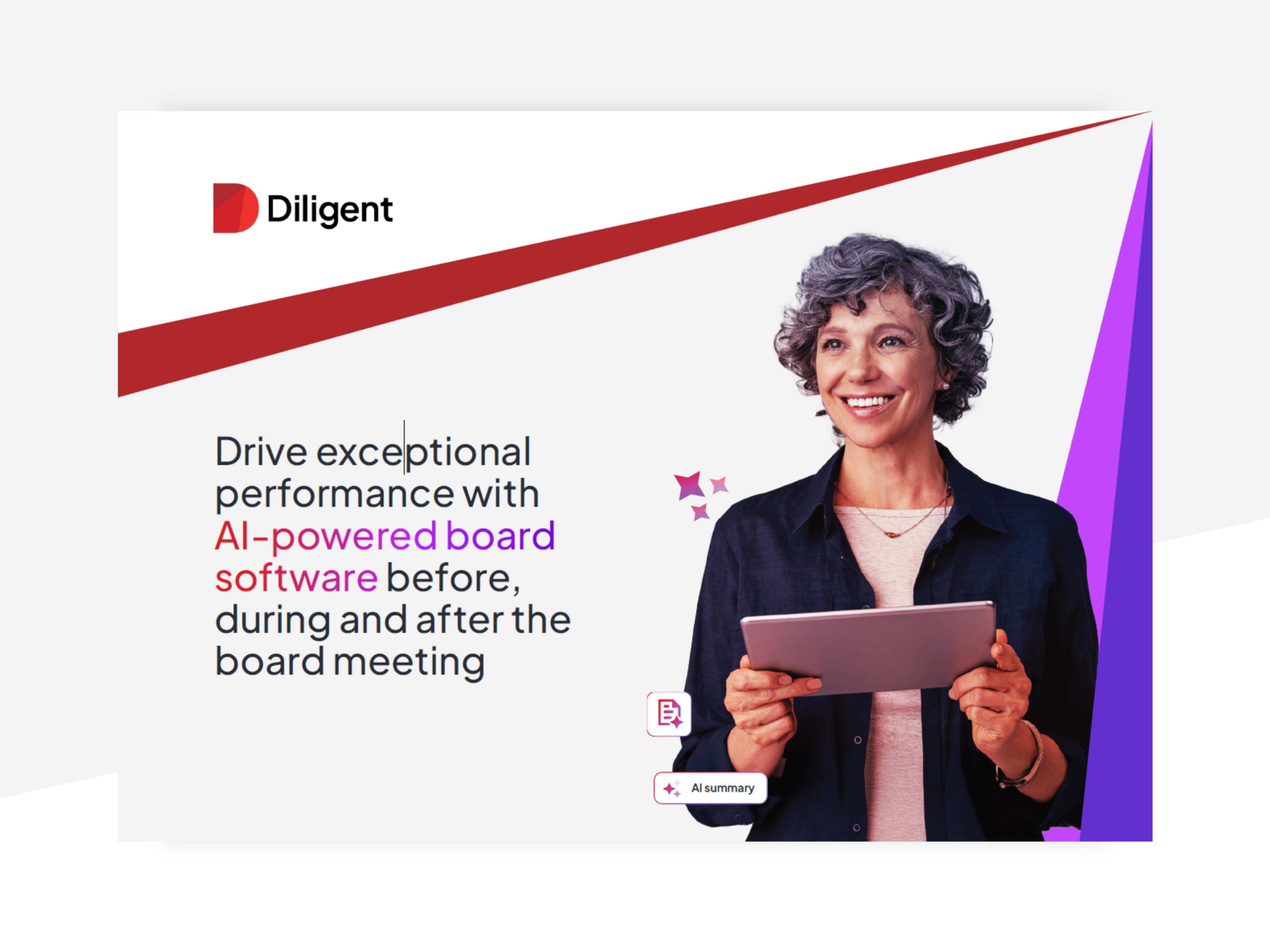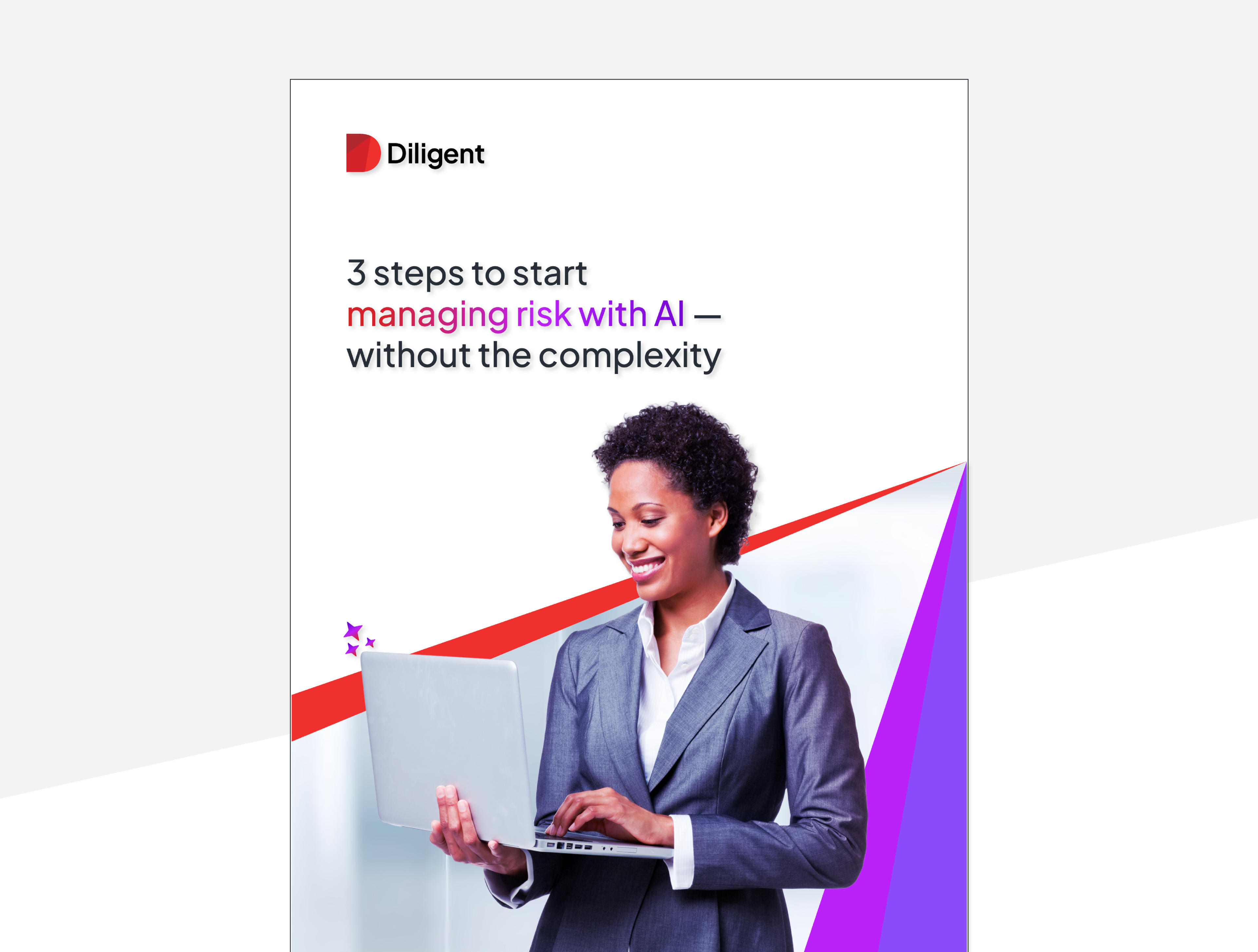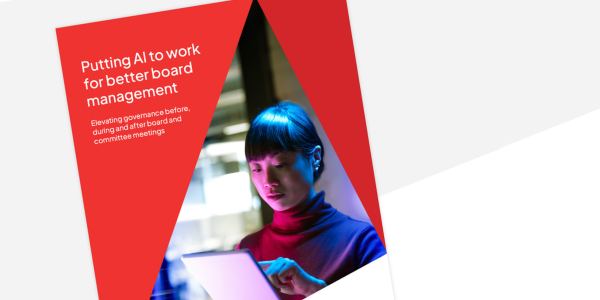5 insights shaping the future of GRC from the AI Innovations Virtual Summit

Whether you joined us live or are exploring the insights for the first time, here’s what stood out and why it matters for the future of GRC.
Artificial intelligence (AI) is no longer a future-facing trend — it’s a current-day accelerator for governance, risk, and compliance (GRC) functions. That was the clear message from Diligent’s AI Innovations Virtual Summit, where leaders from across industries gathered to explore how AI is reshaping the way organizations operate.
Whether you joined the sessions live or are catching up now, these five insights — one from each inspiring session — reveal how AI is being used today to power stronger, faster and more resilient GRC.
1. AI is the bridge between boardrooms and the business
Session: Keynote | How Diligent is Powering the Future of GRC with AI

At the summit’s kickoff, Diligent CEO Brian Stafford laid out a bold vision: AI isn’t just a new tool — it’s the connective tissue between strategy and operations. By embedding AI across its platform, Diligent is helping GRC teams eliminate time-consuming tasks like board book creation, minute-taking and compliance reporting. The result? Teams gain time for higher-impact work and deliver sharper, real-time insights to the boardroom.
Top tip: Meet with your board or executive team to identify “below-the-surface” blind spots (complex areas like risk, compliance or legal workflows) and explore how AI could bring more visibility, speed or insight to those teams.
Streamline board management with AI
Discover how AI-assisted board management software can boost your board’s efficiency, decision-making and strategic planning like never before.
Get your copy2. Build AI with security and compliance from day one
Session: The Big Picture | How AI is Reshaping Governance, Risk, and Compliance

One of the strongest messages from the summit was the need to shift compliance and security “left” — baking them into AI development from the beginning. Waiting until systems are already in production can expose organizations to unnecessary risk, from model drift and bias to regulatory breaches and reputational harm.
Instead, organizations should adopt a multidisciplinary approach, bringing together privacy, legal, security and technical teams to evaluate AI use cases before they launch. This ensures ethical alignment, safeguards against misuse and creates a foundation for continuous monitoring and accountability.
Top tip: Establish a cross-functional AI review process that includes legal, privacy and security from the start — especially for high-impact use cases — to ensure responsible design and deployment.
3. Boards must build AI literacy to lead with confidence
Session: AI for Corporate Governance | What Boards Need to Know Now

CEO Pauline Norstrom emphasized that AI is no longer just an IT or innovation topic — it’s a board-level issue. With AI impacting everything from risk posture to business ethics, directors must engage with the topic strategically. That doesn’t mean learning how to code, but it does mean understanding the types of AI technologies in use, their potential risks and how they align (or conflict) with corporate values.
Top tip: Start with a board-level AI briefing focused on practical concepts — such as machine learning, automation and ethical risk — so directors can ask informed questions and provide meaningful oversight.
4. AI in GRC frees teams to focus on what matters most
Session: AI in Action | How Customers Are Turning Possibilities into Practice

Organizations are already applying AI to streamline compliance processes — automating documentation, monitoring controls and surfacing issues before they escalate. The impact? Less time spent on routine reporting and more time allocated to analysis, judgment and strategy.
This shift isn't just operational; it reflects the growing need for board-level engagement. As compliance functions evolve with AI, leadership must understand how these tools work, what risks they introduce and how to oversee their responsible use. A strong connection between the board and business functions is critical for long-term success.
Top tip: Work with leadership teams to identify daily tasks that are ripe for automation, then ensure oversight processes evolve alongside these tools to maintain transparency and trust.
5. AI transformation isn’t a “big bang” — it’s a blueprint
Session: Closing | Your AI-Powered Blueprint for GRC Success

The final session drove home a powerful message: AI implementation doesn’t need to be overwhelming. Instead, successful organizations are layering AI in strategically — piloting, iterating and expanding based on what works. AI transformation isn’t a one-time event; it’s an ongoing journey that starts with smart, targeted steps aligned with your most pressing GRC needs.
Top tip: Choose one AI use case to pilot over the next quarter. Set clear goals, measure outcomes and use that success to inform future rollouts.
The future of GRC is now
AI isn’t just helping GRC teams work smarter — it’s empowering them to lead. As Stafford said in his keynote, “The future of GRC isn’t five years away, it’s already here.” With AI solutions available now, forward-looking leaders are shifting from exploration to execution — and reaping the benefits.
Take the next step toward smarter governance with purpose-built AI
If you’re looking to turn insight into action, download our free guide: Integrating AI with confidence: A guide for future-focused GRC leaders.
This nine-page resource is designed to help you:
- Ask the right questions when evaluating AI tools
- Choose technology that balances innovation with security
- Boost efficiency for boards along with compliance, audit and risk teams
Whether you're modernizing governance practices or scaling your compliance efforts, this guide will show you how AI can power smarter decisions and stronger oversight — today and into the future.
Download the guide now and uncover the full potential of AI in board, entity and risk management.
Your AI for GRC guide
Regulations are evolving. Risks are multiplying. Pressure is rising. AI can help you stay ahead. This guide walks you through how to evaluate the best solution.
Download nowKeep exploring

Achieve exceptional board performance
Elevate your board's impact. Discover how AI-powered board management enhances meeting performance, collaboration & strategic decision-making.

Introducing Diligent AI Risk Essentials: Your AI-powered shortcut to ERM
With Diligent AI Risk Essentials, move from spreadsheets to smarter, scalable risk management in just days.

Your guide to AI-powered risk management: 3 steps for growing organizations
Learn 3 simple steps to start managing risk with AI—no complexity, no big team needed.

